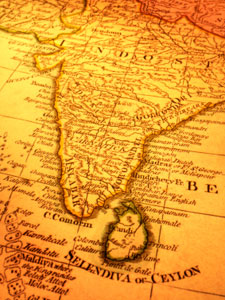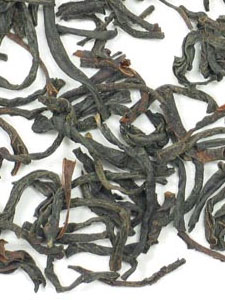Sri Lanka (Ceylon) Tea


"... the tea fields of Ceylon are as true a monument to courage as is the lion at Waterloo." -Sir Arthur Conan Doyle
Known as Ceylon until 1972, the island of Sri Lanka lies a mere 19 miles from the southern coast of India. Blessed with ideal trade winds and geographic diversity, the humid, tropical climate is offset by mountains in the south rising to altitudes of over 8,000 feet. Today, Sri Lanka is the world's fourth largest tea producer and its famous leaves (still called "Ceylon") are cherished for their taste and consistent quality.
History
Until the 1860s there was not a single tea farm in Sri Lanka. Coffee, the island-nation's cash crop, dominated agriculture. It was around this time that James Taylor, a young Scotsman working on a coffee plantation, began to experiment, developing other crops. He started with cinchona (a South American tree, the bark of which is used to produce quinine) and soon acquired tea seeds from the Royal Botanical Gardens of Peradeniya.
For years, Taylor devoted himself to practicing the various methods of tea cultivation and processing (the original tea plants of his Loolecondera estate are, remarkably, still producing) he had learned from Indian tea growers. Despite its ambition, this was a minor experiment that might have been lost to history had fate not intervened. In 1869, a parasitic fungus, hemileia vastatrix, invaded the coffee fields of Ceylon, wiping out entire plantations and rendering the crop defunct.
Coffee farmers falling on financial ruin sought alternative crops among them, the tea experiment at Loolecondera. Taylor, who by then had become famous for his seven acre plantation, was building a full-sized factory when he met a millionaire grocery mogul, Thomas Johnstone Lipton vacationing on the isle. Lipton was interested in cutting out the middleman and selling tea directly to the British consumer. At the time tea was a relative luxury, out of reach for the the working class an untapped market.
The once-booming coffee plantations on the isle were now selling for a song. Lipton bought four and began converting them towards tea cultivation, installing machinery for high volume production. Now able to control supply, quality and price, the grocery baron devoted his energies to packaging. Bright tins, teabags (a relatively new invention) and the slogan "Straight from the tea gardens to the tea pot."
By 1872, two unassuming crates packed with "Ceylon Tea" had arrived in London for auction. By 1875 there were a thousand tea plantations in Ceylon, that number climbing to 300,000 by 1890. At the 1893 Chicago World's Fair, the Lipton company distributed one million of its tea packets. Ceylon had solidified its name in the world of tea and seeing the potential, large British companies began buying up small farms, combining them into large estates.
By 1971, British companies owned more than 80 percent of tea estates in the country. That year, the Sri Lankan government nationalized the majority of plantations. In 1990, a plan began to re-involve private companies in managing the state-owned plantations. This upheaval and uncertainty took its toll on Sri Lankan tea production. In 1993, the island fell from its status as the largest single producer of teas in the world to number eight.
After failing to compete with India and Kenya in the low-cost production of CTC teas, many estates are now converting back to orthodox methods. With industrial tea production sweeping the globe, it's likely Sri Lanka will fall behind in numbers but distinguish itself through tradition and quality. Today, Sri Lanka exports nearly all of its harvest and is fourth among tea producing countries in the world.
Culture
Sri Lanka is a unique country of origin because the tropical climate allows for continual, year-round harvesting. The island features striking microclimates ideal for tea production. Tea in Sri Lanka is classified by elevation: low, medium or high grown. Each is distinct, creating remarkable variety for a country which produces almost exclusively black tea.
The government of Sri Lanka is heavily involved in grading standards (very similar to those of India's) and production quality of commercial farms. An organization called The Sri Lanka Tea Board performs rigorous inspections of would be "Ceylon" teas, emblazoning authentic goods with a Lion logo.
Notable Sri Lankan Teas
Pahata Rata "Low Country" (Sea Level-2,000 ft) Teas grown in the plains and foothills of Sri Lanka produce full bodied, colorful and hearty cups of tea, perfect for cream and sugar. The leaves are often larger, fuller and more wiry in appearance. In recent years, a lovely silver-tipped tea from the Ratnapura region has grown in popularity here in the U.S.
Medarata "Midland" (2,000-4,000 ft) - Like James Taylor's very first tea garden at Loolecondera, these medium-altitude teas tend towards the medium and full bodied with a refreshing citrusy tang, brisk fruity notes and balanced astringency. Our Ceylon Sonata (from Taylor's Kandy region) is a classic example of this well-loved tea type. Example Ceylon Sonata.
Udarata "High Country" (over 4,000 ft) The higher elevation teas from Uva, Dimbula and Nuwara Eliya can resemble a Darjeeling with their golden liquors and fresh, sweet aromas. The colorful dry leaf can even appear similar to the autumn hues of Himalayan teas. Like most Ceylons, these lean more toward a citrus note than muscat grape, the signature of a Darjeeling. Pleasantly crisp, medium bodied and floral - the perfect afternoon cup of tea.
 teaclass
teaclass
